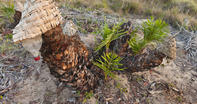
Name
Wild date palm or Senegal date palm (Phoenix reclinata)Description
The wild date palm is an evergreen tree that grows no higher than 6 m. Its leaves are about 3 to 4 m long and resemble a feather, comprised of approximately 50 leaflets per side.
Leaves located closer to the base are spiny, whereas other leaves are shiny, smooth and dark green. These trees occur in dense stands and some with more bended stems may be taller than the rest. The bark of the wild date palm is dark brown to dark grey.
Wild Date Palm Flowers and Fruit
The flowers of this tree are inflorescence, carried in axils of new leaves close to the stem’s apex. Different genders grow on different plants.
The female florets are small, round and yellow-green, whereas the male florets are a light dirty-yellow.
The fruits measure only 2.3 cm by 1.4 cm and grow in large, hanging clusters. The pulp of the fruit is fleshy and yellow, browning with age and having a singular seed.